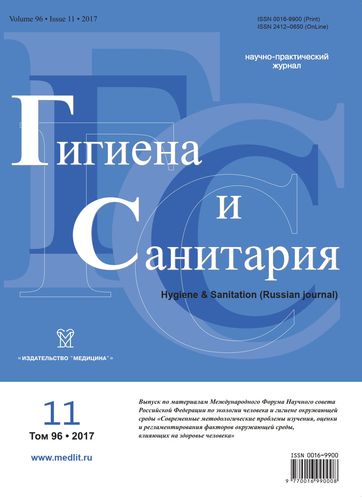Morbidity with temporary loss of work capacity in working population: federal and regional indices and trends over 2005-2014
- Authors: Lebedeva-Nesevrya N.A.1,2, Kostarev V.G.3, Nikiforova N.V.1, Tsinker M.Y.1
-
Affiliations:
- Federal Scientific Center for Medical and Preventive Health Risk Management Technologies
- Perm State National Research University
- Office of the Federal Service for Supervision of Consumer Rights Protection and Human Welfare for the Perm Krai
- Issue: Vol 96, No 11 (2017)
- Pages: 1054-1059
- Section: OCCUPATIONAL HEALTH
- Published: 21.10.2020
- URL: https://ruspoj.com/0016-9900/article/view/640714
- DOI: https://doi.org/10.47470/0016-9900-2017-96-11-1054-1059
- ID: 640714
Cite item
Full Text
Abstract
The article presents data on morbidity with temporary loss of work capacity (MTLWC) among working population in the whole of the Russian Federation and federal districts throughout the period from 2005 to 2014. According to official statistics, common number of losses of working days is shown to decline with a rate of about 1.1-1.3% per year mainly due to a reduction in the number of cases of diseases. The Urals and Privolzhsky Federal Districts are characterized by highest rates both of the incidence rate and the number of days of MTLWC. For the example, the Perm Krai (Privolzhsky Federal District) as a region with a typical MTLWC structure was shown to represent greatest losses of working days in the age groups of 25-29 and 50-54 years of workers of both genders. The consistent high incidence rate of injuries, poisoning and other effects of external influences in working men under the age of 24 years is of particular concern. The situation testifies the need to create targeted programs to prevent diseases in young workers, who in subsequent years will form the bulk of the country’s productive forces. At the regional level MTLWC is established to account for an annual loss of about 1.3-1.5% of the gross regional product. The adoption of effective managerial decisions to reduce MTLWC is shown to allow solve not only medical and demographic, but also economic problems in certain regions and the country as a whole.
About the authors
Natalia A. Lebedeva-Nesevrya
Federal Scientific Center for Medical and Preventive Health Risk Management Technologies; Perm State National Research University
Author for correspondence.
Email: natnes@fcrisk.ru
ORCID iD: 0000-0003-3036-3542
MD, PhD, DSci., Head of the Laboratory of Social Risk Analysis of the Federal Scientific Center for Medical and Preventive Health Risk Management Technologies, Perm, 614045, Russian Federation.
e-mail: natnes@fcrisk.ru
Russian FederationV. G. Kostarev
Office of the Federal Service for Supervision of Consumer Rights Protection and Human Welfare for the Perm Krai
Email: noemail@neicon.ru
Russian Federation
N. V. Nikiforova
Federal Scientific Center for Medical and Preventive Health Risk Management Technologies
Email: noemail@neicon.ru
ORCID iD: 0000-0001-8060-109X
Russian Federation
M. Yu. Tsinker
Federal Scientific Center for Medical and Preventive Health Risk Management Technologies
Email: noemail@neicon.ru
Russian Federation
References
- Izmerov N.F. Concept of long-term social and economic development until 2020 («Strategy 2020») and health preservation for workers in Russia. Meditsina truda I promyshlennaya ekologia. 2012; (3): 1–8. (in Russian)
- Onishchenko G.G. Working conditions and occupational morbidity in workers of the Russian Federation. Gigiena i sanitariya. 2009; 88(3): 66–70. (in Russian)
- Gimpel’son V.E., Zudina A.A. Demographic problems of the labor market. Demoskop Weekly. 2017; (729-730). Available at: http://demoscope.ru/weekly/2017/0729/tema01.php (in Russian)
- Petrov A.Ya. Russia annually loses almost 2% of GDP due to unsatisfactory working conditions. Trudovoe pravo. 2008; (9): 427–52. (in Russian)
- Leonov S.A., Son I.M., Moravskaya S.V. Dynamics of morbidity with a temporary disability in Russian Federation in the period of 2007–2011 years. Menedzher zdravookhraneniya. 2013; (8): 6–14. (in Russian)
- Rumyantseva A.I., Timofeev L.F. Economic damage from morbidity with temporary disability in the Republic of Sakha (Yakutia). In: Modern Problems of the Effectiveness of Health Management: Proceedings of the Scientific and Practical Conference with International Participation [Sovremennye problemy effektivnosti upravleniya zdravookhraneniem: Materialy nauchno-prakticheskoy konferentsii s mezhdunarodnym uchastiem]. Moscow; 2012: 231–3. (in Russian)
- Shchepin V.O. The morbidity of population temporary disability in the Russian Federation. Problemy sotsial’noy gigieny, zdravookhraneniya i istorii meditsiny. 2012; (4): 6–9. (in Russian)
- Levashov S.P. Analyzing and developing criteria for assessing occupational traumatism risks basing on «best practice code». Analiz riska zdorov’yu. 2017; (2): 37–46. (in Russian)
- Kislitsyna V.V. Industrial enterprise workers’ morbidity with temporal disability Al’manakh sovremennoy nauki i obrazovaniya. 2013; (11): 80–2. (in Russian)
- Shamsiyarov N.N., Galiullin A.N. Clinical and statistical analysis of morbidity with temporary disability of the economically active population of Kazan city. Vestnik sovremennoy klinicheskoy meditsiny. 2015; 8(2): 74–9. (in Russian)
- Notkin E.L. On in-depth analysis of the incidence of disability with temporary disability. Gigiena i sanitariya. 1979; (5): 40–6. (in Russian)
- Malayan P., Milokhov V.V., Min’ko V.M., Rusak O.N., Faustov S.A., Tsaplin V.V., et al. Scientific Commentary to the Legislation on the Special Assessment of Working Conditions [Nauchnyy kommentariy k zakonodatel’stvu po spetsial’noy otsenke usloviy truda]. St. Petersburg: IP Pavlushkina V.N.; 2014. (in Russian)
- Leigh J.P., Du J., McCurdy S.A. An estimate of the U.S. government’s undercount of nonfatal occupational injuries and illnesses in agriculture. Ann. Epidemiol. 2014; 24(4): 254–9.
- Mosher G.A., Keren N. Analysis of safety decision-making data using event tree analysis. In: The Association of Technology, Management, and Applied Engineering: Conference Proceedings Papers. Ames: Iowa State University; 2011: 137–42.
Supplementary files









